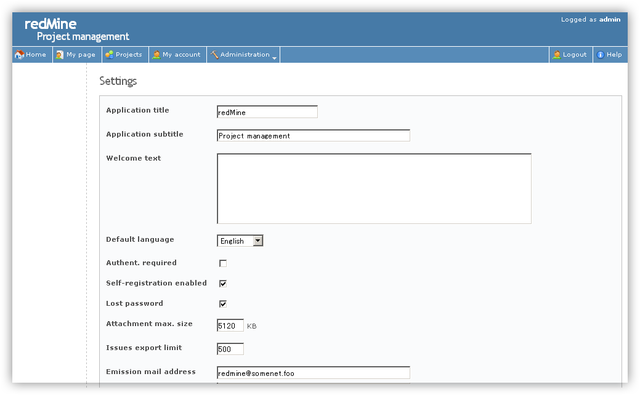

BitNami Redmine Stack Provides an all-in-one installer and free virtual machines and cloud images for Redmine. It can be deployed using a native installer, as a virtual machine, in the cloud or as a module over an already installed infrastructure Stack. TurnKey Redmine Appliance - Provides a free lightweight Debian-based Redmine appliance (available as an ISO, virtual machine image or cloud image). Greatly simplifies the deployment of Redmine and its required dependencies. Greatly simplifies the deployment of Redmine. Per project wiki - Per project forums - Simple time tracking functionality - Many more features - Update Redmine to 1.0.3 - Update Apache to 2.2.17 Flexible issue tracking system - Gantt chart and calendar - News, documents and files management - Feeds and email notifications. Its main features are: - Multiple projects support - Flexible role based access control. Written using Ruby on Rails framework, it is cross-platform and cross-database. Redmine is a flexible project management web application. It can be deployed using a native installer, as a virtual machine, in the cloud or as a module over an already installed infrastructure Stack. Upload the file redmine_ to the new server.Greatly simplifies the deployment of Redmine and its required dependencies. Stop Apache: $ sudo /opt/bitnami/ctlscript.sh stop apache

Launch a new Redmine server and follow the steps below: $ tar czf /tmp/redmine-backup/redmine_ plugins Depending on your installation type, execute the following commands:Īpproach A (Bitnami installations using system packages): $ cd /opt/bitnami/redmineĪpproach B (Self-contained Bitnami installations): $ cd /opt/bitnami/apps/redmine/htdocs/Ĭompress Redmine application and plugin files from the files directory into the temporary backup folder: $ tar czf /tmp/redmine-backup/redmine_ files Navigate to the Redmine installation directory. On the original Redmine server, follow the steps below:Ĭreate a temporary folder for the backup: $ mkdir /tmp/redmine-backupĬreate a database backup file named bitnami_redmine.sql in the temporary backup folder: $ mysqldump -u root -p -databases bitnami_redmine -add-drop-database > /tmp/redmine-backup/bitnami_redmine.sql The recommended way to upgrade Redmine is to migrate all the data to a fresh Bitnami installation, which runs the updated version of Redmine. If you have important data, it is advisable that you create and try to restore a backup to ensure that everything works properly.

It is strongly recommended that you create a full backup before starting the update process. Refer to the FAQ for more information on these changes. See RedmineUpgrade - in general, you likely want to. Make sure to run the database migrations after you imported the database. Make sure that your new Redmine version is the same version (or newer) than your old Bitnami Redmine version. The output of the command indicates which approach (A or B) is used by the installation, and will allow you to identify the paths, configuration and commands to use in this guide. RE: Issue Migration Bitnami Redmine 3.2.0.1 to Redmine (not bitnami) - Added by Holger Just 20 days ago. To identify your Bitnami installation type and what approach to follow, run the command below: $ test ! -f "/opt/bitnami/common/bin/openssl" & echo "Approach A: Using system packages." || echo "Approach B: Self-contained installation." On account of these changes, the file paths stated in this guide may change depending on whether your Bitnami stack uses native Linux system packages (Approach A), or if it is a self-contained installation (Approach B). NOTE: We are in the process of modifying the file structure and configuration for many Bitnami stacks.


 0 kommentar(er)
0 kommentar(er)
